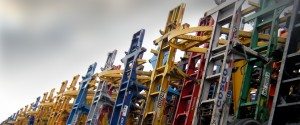Chassis providers to Share their Fleets
The current chassis provisioning model is not sustainable, so competitors plan to reach agreement on sharing equipment.
Chassis equipment owners serving the Port of New York-New Jersey are scheduled to meet Wednesday afternoon to decide on a collaborative plan for optimizing the utilization of wheeled trailers used to move containers in the region.
John Nardi, president of the New York Shipping Association, said chassis-leasing companies, ocean carriers and others will agree to establish an interchangeable “gray pool,” hammering out the form it will take and the parameters for pool management.
A gray pool simply allows equipment contributors to share their fleets. A company that contributes 1,000 chassis, for example, can lease or use 1,000 chassis owned by anyone in the pool.
Nardi spoke Monday during a panel discussion on ocean carrier transportation at the National Industrial Transportation League’s annual conference in Fort Lauderdale, Fla.
 A shortage of available chassis in New York and New Jersey, as well as some other ports, has significantly contributed to congestion at marine terminals for the better part of a year. Demand for the frames has increased along with spikes in cargo volumes associated with big vessels, but they are often stored in locations far from terminals where they are needed, or they are out of service.
A shortage of available chassis in New York and New Jersey, as well as some other ports, has significantly contributed to congestion at marine terminals for the better part of a year. Demand for the frames has increased along with spikes in cargo volumes associated with big vessels, but they are often stored in locations far from terminals where they are needed, or they are out of service.
Although ocean carriers have largely exited the business of providing chassis for their customers under an all-in transport rate, the fleets they sold to leasing companies came with strings attached requiring the equipment be exclusively used for its containers. That means a drayage company has to return a leasing company’s equipment and go to a separate location to secure another one before heading to the terminal’s transfer zone to pick up a container for a different ocean carrier. Chassis-leasing providers also incur heavy expenses repositioning chassis.
“We think that going to a gray pool in New York is really going to increase the capacity available to everybody because you don’t have all these additional moves in the port,” said Nardi, who chairs the equipment working group within the Council on Port Performance. The council was established last summer to engage stakeholders on ways to implement 23 recommendations of a task force on port performance following wide-scale delays processing trucks.
There are three chassis-leasing providers in the Port of New York-New Jersey (TRAC Intermodal, Flexi-Van Leasing and Direct ChassisLink Inc.), plus two ocean carriers that still provide chassis (Mediterranean Shipping Co. and Evergreen), and some truckers with their own equipment.
The pool will either be a market pool managed by a single entity, or a pool of pools, where each pool operates on its own but shares chassis through a port-wide usage agreement, Nardi said.
Details will be finalized in the coming weeks, with a gray chassis pool likely to start operating in the second quarter of 2015.
A neutral entity will also be selected to manage the pool, with responsibility for operations, maintenance, identifying who is using each piece of equipment and for how long so owners can properly bill customers, and dividing the operating cost among the owners. Consolidated Chassis Management, for example, manages pools in the Southeast and Gulf regions
The commercial relationships between the chassis owners and their customers will remain intact, independent of the pool manager.
In addition to the raw number of chassis in the port and the lack of interoperability, another supply constraint is a shortage of skilled mechanics, according to freight industry officials. Nardi said the system requires mechanics who are dedicated to fixing chassis because otherwise marine terminals will pull them from work on chassis to address higher-priority repairs such as refrigerated containers or cargo-handling equipment.
Keith Lovetro, the head of TRAC, recommended at a recent Federal Maritime Commission meeting on port congestion that pools be located outside of terminals so terminals can’t poach mechanics for other jobs.
Nardi also reiterated long-standing complaints that the Waterfront Commission, which was established decades ago as a way to monitor organized crime activity on the docks, is restraining the ability of terminals and chassis providers to hire enough mechanics.
The NYSA, which represents marine terminals and ocean carriers in labor negotiations at the port, and the International Longshoremen’s Association have been fighting the Waterfront Commission for more than a year over the organization’s alleged slowness in allowing them to expand the workforce following conclusion of a six-year labor agreement. The commission policies the docks by performing background checks on waterfront workers and regulates the supply of longshoremen who handle cargo at facilities in New York and New Jersey.
The Council on Port Performance, which is comprised of representatives from various industry sectors and the port authority, is currently analyzing demand in the port for how many permanent mechanics are needed to fix chassis every day, Nardi said.
Chassis providers in the Los Angeles-Long Beach area have also agreed to come together to form an interchangeable gray pool in the area.
